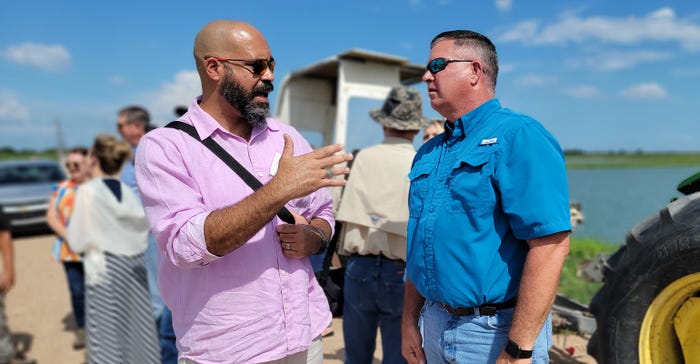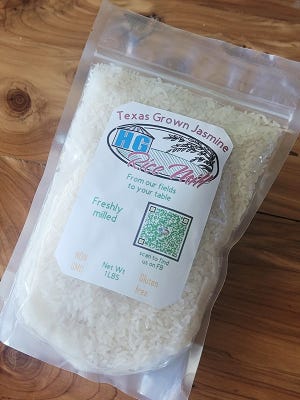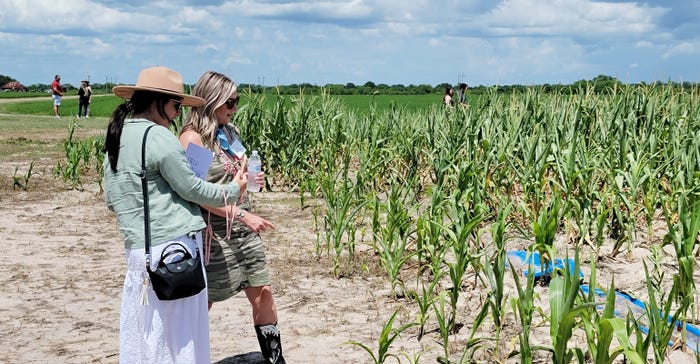
Texas food bloggers and influencers recently broke from their kitchens and metropolitan restaurants to attend the 2022 Field to Fork event in Matagorda and Wharton counties. They toured two farms and a cotton gin, learning more about where the food they write about originates and the sustainable practices used to grow them.
The event, sponsored by Water Grows, an initiative between the Texas NRCS and Texas Corn Producers, kicked off at Daniel and Dillon Berglunds' farm. Against the backdrop of his irrigated rice field, Daniel discussed conservation practices utilized for crop production, as attendees ate a dish of dirty rice with corn aioli prepared with rice grown by farming neighbors, Ben and Debbie Hoffpauir.
"We're trying to conserve our natural resources to make a sustainable industry here," Daniel told the crowd. "Some of our resources are limited and finite, so we want to make sure we use them efficiently through the practices we're using."

Producer Daniel Berglund shares how he is sustainably producing this nation's food and fiber on his farm in Matagorda County, Texas. (Photo by Shelley E. Huguley)
The Berglunds produce rice, corn, soybeans, cotton, and sorghum. Daniel began by introducing attendees, many of whom had never visited a farm, to the value of crop rotation for weed control.
"We can use different chemistries on the different crops," Daniel told the crowd. "What we can use on rice, we can't use on corn and we can't use on cotton. By doing this rotation, we can control the weeds and grass more economically and we're using less chemicals, which is good for the environment and it's also good for the soil."
He also discussed the challenging drought. "We have an average rainfall of about 46 inches. Last year, we had almost 60, which was too much. This year, we've only had about 8.5 inches, three of which fell 10 days ago, so we started out dry and it's been dry."
USDA NRCS partnership
Daniel introduced conservation practices he and Dillon have utilized with the help of USDA NRCS programs. He began with irrigation land leveling. "What that's done is create a general slope of the land so we get a minimal flood, which requires less water, so we can conserve water use."

Learning from one another. Hector Rivera, left, visits with Mark Kubecka, Homegrown Seafood, at the fish farm. (Photo by Shelley E. Huguley)
He also explained the benefit of an irrigation pipeline.
"Years ago, right where you are standing, there was a canal where water used to come through but there was a lot of evaporation and percolation and trees that utilized that water, so it didn't get to the field. By utilizing underground pipe and taking it to each field, the minute I turn on the well, the water comes out, almost immediately, right at the field, so it saves about a 25% to 35% water, depending on the year."
He also explained the benefit of using multiple inlets on the blue poly pipes lining the fields. "It takes the water to each cut or each bay in the field. That way we can put the water where we need it and not have to cascade from the top down. That saves another 25% to 30% of water each year, depending on the rainfall.
 Texas-grown rice was included in the event swag bags, as well as included in dishes served at the event. (Photo by Shelley E. Huguley)
Texas-grown rice was included in the event swag bags, as well as included in dishes served at the event. (Photo by Shelley E. Huguley)
"It also allows us to set our plastic overflows on each levee, so the water will go down the hill uniformly but stop the water. That way we don't have to keep it full and running over the plastics all the time. So, if we do get a rain event, we can capture it, shut the well off for a couple of days -- another way to save ground water."
See, Texas Coastal Bend crops struggling, cotton shows potential
He also highlighted the use of variable speed drive electric motors. "It's a very fuel-efficient way to pump water. And with the variable speed drive, we can judge how much water we need going into the field. We can start it slow and bring it up and slow it down, and we use less electricity based on how fast it's running.
"We also have water control structures," Daniel says as he points to the aluminum box located behind the guests. "It allows you to drain the water out of the field. The pipes are down below the soil surface but then we put boards in there, so the topsoil stays in the field and water comes out. It reduces soil erosion and keeps the soil and nutrients in the field rather than down the ditch."
Nutrient management
Another USDA NRCS program the Berglunds discussed is nutrient management practices. "We utilize it on corn, soybeans, rice and cotton. We utilize soil mapping and soil sampling and then we prescribe how much we're going to put out at a variable rate, so that we don't put out more than it needs but we make sure it gets what it needs on each area of the field."

After the Berglunds' talked about production on their farm, attendees were invited to walk around the fields. Daniel Berglund not only discussed farm successes but was honest about challenges, including this struggling corn crop, which was shocked by a pattern of drought followed by irrigation and then rainfall. "It's been a tough, tough year for corn." (Photo by Shelley E. Huguley)
Daniel also explained the benefits of GPS on their tractors and spray rigs to reduce overlap and therefore trips in the field. "That also helps with labor, time and fuel consumption," Daniel added.
He then pointed to a red sprayer parked nearby. "It has a 120-foot boom with 19-inch spacing on the tips. Every 19 inches it will cut off when it goes to overlap, so we minimize waste of insecticide or herbicides. We don't have any excess going into the atmosphere."
Dillon said the NRCS has been helpful getting their farm in shape. "It was pretty rough when we started. The practices have saved a lot of hours and water. The farm is at least 100% or more efficient than when we got here."
Providing perspective
Daniel provided insight on the impact inflation's having on the family farm. "When you see the price go up on the (store) shelf, a lot of that is transportation-related, it's also labor and packaging but mostly fuel," Daniel tells the crowd. "Ag is the number one consumer of fuel, petroleum products and steel in the United States, so we feel it hard. Our diesel products are double what they were a year ago. Fertilizer prices are anywhere from two to three times higher than they were a year ago. The markets on the corn, cotton and soybeans have been up due to issues around the globe and that's kind of kept up with the cost of production. Rice so far hasn't. It's up but it's not nearly what it needs to be to keep up with the expenses we're incurring.
See, The secret garden: Where all daddies are farmers

NRCS staff were on hand to visit with attendees at the Field to Fork event. (Photo by Shelley E. Huguley)
"But we can hope and pray for our markets and yields to improve. The yields can make up for low prices if you can get a good yield. We feel the crunch, and the bad part is we can't pass that on to you. When you get a cost increase, that's from the retailers. We're a price taker. Not a price maker. I have to be the low-cost provider, or they'll go to the next guy."
Lastly, Daniel explained how, with the assistance of NRCS and Ducks Unlimited, he's creating wildlife habitat. "Using these water control structures, after we harvest the crops, on some fields, we'll close them up and catch the rainwater. We'll manipulate up to 50% of the acres so it's attractive to migratory game birds and shore birds. So, we'll maintain a flood, based on rainfall, anywhere from 16 to 18 inches at the bottom of the field and then shallower as we go up the field. That's something we've really enjoyed doing and our landlords can utilize that for duck and goose hunting."
*Take a look through this photo gallery to learn more about the tour and hear from attendees about what stood out to them as they visited the farms, many for the first time. They are very insightful!
*Editor's note: This article was updated June 21, 2022, to reflect Ben and Debbie Hoffpaurir as the producers who grew the rice included in dishes served at the event and donated a pound of rice to each attendee to try at home.
About the Author(s)
You May Also Like






